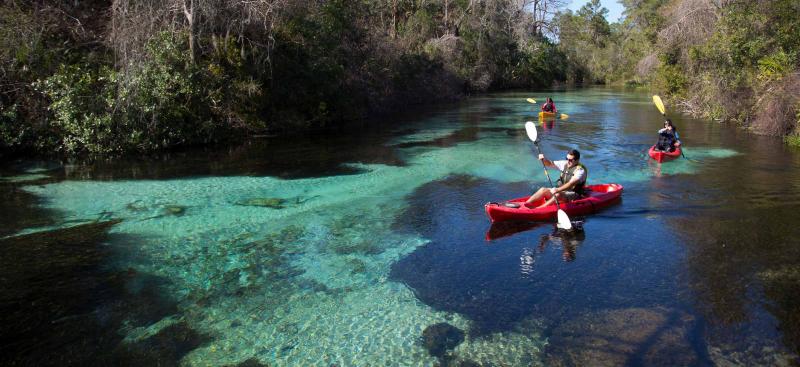The District uses a variety of tools to protect our springs but it takes a community effort by all of us.
There is no single solution to protecting Florida springs. The District uses a variety of tools to help protect them. But it takes the work of all of us to protect these resources. There are various ways you can help when visiting a spring and even at home.
How to responsibly enjoy a spring:
- Stay in the vessel when possible.
- If you have to leave the vessel, tie off in shallow waters.
- Avoid docking on riverbanks.
- Don’t trample vegetation or kick up silt.
- Avoid climbing on banks.
- Don’t climb trees or use rope swings.
- Don’t throw out litter or leave anything behind.
- Trim boat motors to prevent propeller scarring.
These are good tips to remember no matter what spring or river system you visit. But also remember each system may have its own rules and regulations to follow.
How to protect springs at home:

- Use fertilizer sparingly. Too much fertilizer applied to landscapes can seep into the aquifer or run off into nearby waterways.
- Use these Fertilizing 101 tips to reduce impacts when fertilizing, or hire a Green Industries Best Management Practices certified professional to maintain your lawn.
- Have septic tanks inspected every two to three years. Septic tanks that are not properly maintained can pollute the groundwater that ultimately emerges from springs.
- Never dump anything down a storm drain and always dispose of grass clippings, litter, motor oil and pet waste properly to avoid these items entering stormwater ponds, which help prevent flooding and filter out pollutants before they reach water bodies.
- Plant a buffer zone between the lawn and shoreline and avoid cutting your lawn too short, which reduces its ability to capture and filter water before it enters a stormwater pond or water body.
- Always dispose of hazardous household chemicals such as industrial cleaners, solvents, automotive fluids and paints at an approved landfill. Never discard of these items or other debris into a sinkhole, which are often directly connected to the aquifer. As a result, hazardous contaminants can seep into the aquifer, our drinking water and springs.
How the District helps protect springs:
Since each spring system is unqiue and complex, the District uses a variety of techniques to address each system's challenges:
- Data collection and monitoring: Springs protection starts with data collection and monitoring. The District collects and monitors various types of data including rainfall, water clarity and salinity. The data goes through an extensive quality control process and is published to our Environmental Data Portal.
- Analysis and planning: Once you have sufficient data, you can analyze it and look for trends. This information is used to develop District management plans. These plans guide the focus for management actions using an adaptive management strategy.
- Stormwater and restoration projects: The District funds and implements stormwater improvement and natural system restoration projects. These projects help reduce nutrients from entering water systems, benefit water quality and/or improve habitat.
Conservation and reuse efforts: The District prioritizes water conservation and reclaimed water projects.

Even as population has increased in the District’s northern region, groundwater use has declined. This is due to conservation efforts and implementing reclaimed water projects, which offset the demand on groundwater withdrawals.
- Land acquisition: The region’s lands and waters are forever linked by Florida’s natural water cycles. Therefore, the District acquires and manages conservation lands around lakes, rivers, springs, wetlands and estuaries to help protect them.
- State laws and regulation: Florida statutes require state water management districts to establish minimum flows and levels, which are the limit at which further withdrawals would be significantly harmful to the water resources or ecology of the area. Also under state law, the District is responsible for issuing various types of permits that ultimately protect water resources.
- Outreach and education: Through various communication tactics like social media, speaking engagements and educational programs, the District informs residents about important water issues and engages them to protect our water resources through conservation and responsible best practices.
How Septic Tanks Impact Springs »

